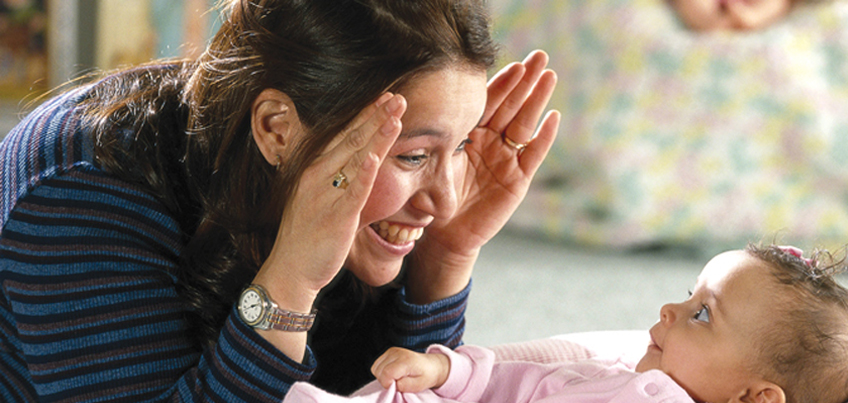Infants and toddlers are observant, curious and eager to explore. Natural pattern-seekers, infants observe their caregivers and environments, noticing similarities and differences, repetition and novelty. As they begin to interact with their environments, toddlers use these observations to learn about objects and patterns. Skilled caregivers encourage this natural curiosity to build strong foundations for mathematical thinking, often using what looks like simple play activities to build the foundation for later learning.
Check out and use these examples of activities that support later math learning. This can also be used as an example to show families about how learning can happen through play.
Peek-a-boo for object permanence
Activity: An infant sits across from their caregiver on the floor, making eye contact. The caregiver covers his own face with his hands, pauses, uncovers his face and says “peek-a-boo!” The infant smiles and continues watching the caregiver. This exchange is repeated multiple times while the infant shows interest. With each repetition, the infant watches intently as the caregiver covers his face, laughing each time the caregiver says “peek-a-boo.”
So, how does this support later math development?
Each time the caregiver covers and uncovers his face, the infant gains an experience with object permanence—the understanding that objects exist, even when out of view. Understanding object permanence in infancy begins to set the foundation for symbolic thinking and concepts of adding and subtracting, which children develop through hands-on experiences in the preschool years.
Tunnel play and spatial talk
Activity: A caregiver sets up a portable play tunnel for the crawling infants to explore. As the first infant shows interest and crawls toward the tunnel, the caregiver encourages the infant, saying, “You’re close to the tunnel, you’re almost there.” As the child crawls into the tunnel, the caregiver exclaims, “Now you’re inside the tunnel!” When the child emerges the caregiver announces, “You did it! Now you’re outside the tunnel again!” The caregiver playfully pokes her head in the tunnel and remarks, “Now I’m in the tunnel,” then pulls her head out and announces, “I’m out again!”
So, how does this support later math development?
As infants develop motor skills, they gain experience coordinating their actions to move their bodies through space. The caregiver narrates these actions using the positional terms close, far, inside and outside, introducing new words to the infants. Exposure to positional language during real-life experiences helps lay the foundation for spatial reasoning, an important component of geometry.
Sensory dig for sorting
Activity: Two toddlers dig into a shallow plastic bin filled with sand. The toddlers squeal as they begin to uncover leaves, sticks and pinecones buried in the sand. After the initial excitement, they continue to examine and observe the items. One child begins separating the leaves and arranging them on the floor near the bin. The caregiver joins the activity with the children. She responds when the children gesture and make statements about the objects. As a child pulls items out of the sand and holds them up, the caregiver names the items and describes the sizes, colors and textures, using the words large, small, long and short to compare the leaves, stems and sticks.
So, how does this support later math development?
The toddlers’ caregiver has set up an engaging activity with new and interesting items for the children to explore, providing an exercise in attention, exploration and discovery. As one toddler separates the leaves from the other items and arranges them on the floor, he is beginning to practice sorting. Sorting skills provide a base for data organization and analysis, which he will begin to develop in the preschool years through further hands-on experiences and adult guidance. The caregiver’s intentional introduction of math words such as long, short, large and small also support these sorting skills and lay the foundation for understanding measurement.
Early experience awakens the mathematician
As in all domains of learning, what caregivers do in the infant and toddler years helps to support later learning. Early experiences awaken each child’s inner mathematician and encourage children to follow their instincts to observe, sort, compare, match, analyze and move objects through space. Your intentional efforts support children’s discovery of the beauty and wonder of math, resulting in children who are curious and eager to learn new math concepts in kindergarten and beyond.
Additional resources
Explore these resources to help you plan activities that build the foundation for math learning:
Arizona’s Infant and Toddler Developmental Guidelines provide a framework for understanding and communicating developmentally appropriate expectations for young children. Caregiver strategies are included to help adults support children’s optimal learning and development.
Arizona’s Early Learning Standards (4th Edition) provides a framework for planning quality learning experiences for children 3 to 5 years of age. An alignment matrix shows the continuum of skill development from the infant and toddler stages through early childhood and the Arizona Kindergarten Standards. The mathematics standard includes goals and outcomes for children’s math learning, with ideas for integration of mathematics concepts across other domains of learning.
NAEYC’s Math Talk with Infants and Toddlers provides tips for weaving math talk into everyday conversations.
Zero to Three provides Let’s Talk About Math! An early math video series (in English and Spanish) highlighting the foundation of early math skills in the first 5 years of life.
Have a story you’d like to share?
We’d love to hear how you support children’s early math learning. Please send us an email with your ideas and story to QualityFirst@firstthingsfirst.org.
